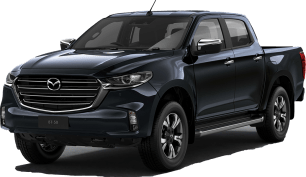Months out from launch, we're here at the famous Durability Circuit deep within Ford's You Yangs Proving Ground, to try out the Ranger V6 for the first time.
For all you students of Australian motoring history, this is the same course that helped make generations of the Falcon the so-called "Great Australian Road Car" from the early Sixties to the end of Ford's local production in 2016.
Keep in mind, though, that it's only three fast laps in the new Ranger V6, sadly, it's supervised at all times by nervous Ford personnel as we're in an extremely expensive pre-production prototype, and we're not forgetting that driving a Ford at the You Yangs gives the new truck a home-ground advantage, since it's literally been designed and developed to be its best right here.
But this quick spin is still more than enough for us to give you an initial taste of the changes made between old and new Ranger.
And to refresh our memories, we've also had a run in the old Ranger – a PX III series Wildtrak BiTurbo with the 2.0-litre twin-turbo four-cylinder diesel powertrain ¬– that highlights the many advances of the latest version.
Anyway, we're strapped in and finally ready to go!
Accompanied by the deep baritone exhaust note that can only be from a V6 turbo-diesel, initial acceleration is strong, with a decent amount of forward thrust on hand – or, rather, underfoot – even if you just tickle the throttle.
While the old 2.0-litre BiTurbo Ranger reacted fairly quickly when asked to simulate an overtaking manoeuvre at speed, the V6 lunged ahead, to power along much more briskly and with not much provocation from the pedal, highlighting the next level of performance that paying the extra $3000 brings to the Ford.
And even for this late-stage prototype, there's a sophisticated level of tuning going on here, as revealed by how progressively the truck responds to the driver's commands. The brakes pull up cleanly; the steering is light yet has a good deal of feel as well as feedback; and through the really fast corners, there's impressive composure and control, that elevates an already class-leading pick-up to what we believe will be new heights for this sort of vehicle.
One section of the Durability Circuit includes bumps and cobblestones that are designed to disrupt the suspension's ability to soak up or ride over them at speed; in our unladen Wildtrak, and with the newly redesigned independent wishbone coil-sprung front and leaf-sprung rear suspension set-up fitted, the Ford sailed over these, with little of the lateral 'crabbing' that was evident in the PX III Wildtrak we sampled straight after.
So, after three quick laps in the new Ranger V6 that ended all-too-soon, we're quietly confident that Ford might have upped the ante in terms of engine performance, handling capability and ride comfort.
And the sound of that 3.0L V6 just amplifies as well as elevates the experience even further.
Clearly, we need to drive a Ranger away from its home base before we know definitively, but all the signs are extremely promising indeed.
And it was also telling to see just how good the old version still feels behind the wheel.
Ford also gave us an opportunity to try out the new Ranger V6's capabilities off-road. Again, back-to-back with an old Wildtrak to see how far it's come. Being a Wildtrak, it had the new electronic 4WD system.
And the biggest takeaway here is just how easy it is to drive the new model off-road, by selecting one of the drive modes on screen and letting the vehicle do the rest. That screen displays driveline and diff lock status, steering angle and vehicle pitch and roll angles.
It's also quite surprising how much more planted and surefooted the new Ranger feels.
Ford's claims about it having more wheel travel and articulation are realised driving the new Ranger over the deep ruts and potholes that make up the You Yang's off-road course, with the suspension doing a great job soaking up or traversing the bumps and thumps.
Plus, the V6 has the torque to really power up very steep inclines without struggling at all, while the new hill descent tech takes care of going down again, without the driver having to break a sweat.
In fact, it's how composed and in control the vehicle now feels off-road that separates the new from old Ranger, backed up by an engine that offers ample performance to do it.
Like we said, we'll need to take the new Ford ute out in the real world to make sure it's as good as it feels around the You Yangs, but first impressions suggest that few other midsized trucks anywhere in the world can offer the sort of bandwidth that the new-gen Ranger seems to have in spades.
We can't wait for that.






































